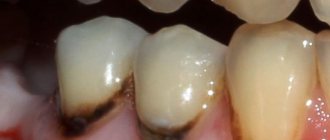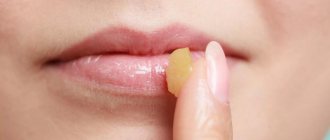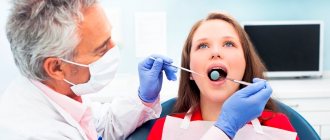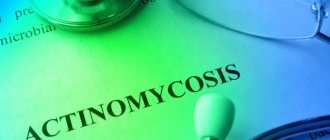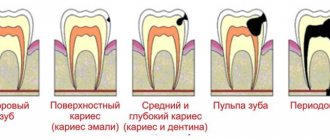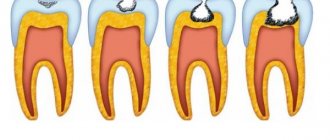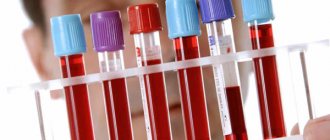In the jaw lymph nodes, the lymph circulating in the cells and capillaries of the oral cavity and head area is processed. Submandibular lymphadenitis is a polyetiological disease: its development can be caused by both chronic diseases and infections in the acute stage. The disease requires mandatory treatment from a specialist; it is impossible to cure lymphadenitis on your own .
What is submandibular lymphadenitis, stages of development
Submandibular lymphadenitis is called inflammation of the cervical and submandibular lymph nodes , which can be acute or chronic. Often the disease is secondary, that is, it does not occur independently, but as a symptom of a primary infection.
Acute stage
In the acute form of the disease, one lymph node or several may become inflamed. Depending on what kind of exudate is contained in the inflamed node - pus or serous fluid - lymphadenitis is divided into purulent and non-purulent. The acute form of the disease is treated by removing pus from the lymph node and eliminating the root cause of inflammation.
If there is pus inside the lymph node, there is a danger of it breaking through and infecting surrounding tissues.
Chronic stage
The transition of the disease to the chronic phase is a consequence of the lack of adequate treatment. The node no longer increases in size and hardens. The pain syndrome intensifies, and severe intoxication of the body occurs. The skin around the node becomes purple.
Compared to the acute phase of the disease, with chronic lymphadenitis there is a clearly noticeable increase in the area of inflamed tissue around the lymph node . The danger of this form of pathology is that it may require removal of the lymph node.
Causes and main symptoms of lymphadenitis in the maxillofacial area
Location of lymph nodes on the head and neck
In the generally accepted classification there is a diagnosis such as “submandibular lymphadenitis,” the ICD code 10 of which consists of two parts and looks like this: L04 Acute lymphadenitis and L04.0 Acute lymphadenitis of the face, head and neck.
In general, lymphadenitis of the maxillofacial area refers to odontogenic and non-odontogenic diseases, that is, they arise as a complication of a dental nature or due to diseases of the ear, nose and throat and other inflammatory diseases of the maxillofacial area, including skin ones. Much less often, this condition occurs initially.
Along the flow, the following forms are distinguished:
- spicy;
- subacute;
- chronic.
Describing submandibular lymphadenitis, its causes can be listed as follows:
- multiple caries;
- pulpitis;
- periodontitis;
- diseases of the gums and mucous membranes;
- pathology of ENT organs;
- specific infections (syphilis, tuberculosis).
Acute form
Acute submandibular lymphadenitis, like any acute inflammatory disease, gives more extensive symptoms than chronic. The body temperature rises to 38 degrees, the patient’s general condition suffers, and there may be chills.
A swelling appears in the submandibular region; palpation reveals enlarged lymph nodes under the lower jaw, which have a dense elastic structure and are not fused with the surrounding tissues. There may be skin hyperemia. Palpation here is painful.
Chronic form
Chronic submandibular lymphadenitis can also be detected by external examination, namely by palpation. In this case, there will also be an increase in size, but the pain will be less pronounced. The chronic form of the disease occurs more often as a result of acute lymphadenitis, in the absence or ineffectiveness of its treatment.
Palpation
Purulent form
Purulent lymphadenitis gives even more symptoms than acute lymphadenitis. Body temperature is also increased to 38-40 degrees, general symptoms are observed - chills, sweating. With such submandibular lymphadenitis, symptoms of purulent inflammation appear on the face, patients complain of acute throbbing pain of a constant nature in the area of the affected lymph node, skin hyperemia is significant, tissues are tense on palpation, fluctuation can be determined.
If conservative treatment is ineffective, surgical treatment is performed in this case. In addition to other symptoms of maxillary lymphadenitis, it is also determined by laboratory tests. The CBC will show an increase in the number of leukocytes and an accelerated ESR.
Causes of submandibular lymphadenitis
Inflammation of the cervical and jaw lymph nodes is associated primarily with diseases of the oral cavity and respiratory system. The main causes of submandibular lymphadenitis are:
- An acute respiratory infection of viral or bacterial origin without a characteristic localization.
- Dental diseases. Especially often, the cause of the inflammatory process in the submandibular lymph nodes is advanced caries or one of its complications: pulpitis, periodontitis, gingivitis, periodontitis, periodontal disease.
- A history of throat diseases: tonsillitis, chronic sore throat, pharyngitis, adenoiditis.
- Acute otitis.
- Chronic or acute inflammation of the nasal sinuses: frontal sinusitis, sinusitis, sinusitis.
- Mechanical damage to the submandibular lymph node caused by trauma.
- The presence in the body of foci of chronic inflammation, characteristic of rheumatoid arthritis, STDs, HIV.
- Infection of the body with Koch's bacillus. The presence of a microorganism does not necessarily entail the development of a tuberculosis process, so the patient may not be aware of the infection. But even in a depressed state, Koch's wand can affect the lymph nodes.
Causes and symptoms
Lymph nodes in the body play the role of a kind of filter: they prevent the entry and spread of various types of infections, and are directly connected to the circulatory system. But in the case when harmful bacteria enter the body and cause the appearance of any inflammatory processes, they begin to settle in the lymph nodes and cause an inflammatory process.
Thus, submandibular lymphadenitis is a consequence of the spread and development of infection in the body . Most often, the cause of this disease is the consequences of inflammatory processes in the oral cavity, with chronic tonsillitis and the manifestation of pustular skin lesions (ulcers, ulcers, fistulas, and so on).
When infectious bacteria settle in the lymph nodes, they begin to become inflamed and increase in size (and this can happen to several nodes at the same time). Therefore, the following symptoms begin to appear:
- When pressing on the areas behind the ears and under the jaw, a painful sensation appears.
- Later, swelling appears in this area, which can turn into redness of the oral mucosa.
Therefore, when the first symptoms appear, it is necessary to consult a doctor and begin treatment so that the pain does not become piercingly shooting and pus does not begin to come out under the skin.
Symptoms, photos and diagnosis of submandibular lymphadenitis
Submandibular lymphadenitis can be distinguished from the usual enlarged lymph nodes, which occurs with reduced immunity, by the presence of pain and compaction. If there is no pain when you touch the node and the lump is not palpable, its enlargement may be caused by decreased immunity. A compacted lymph node can signal the development of oncology, so if it is detected, it is necessary to urgently be examined by a doctor.
Submandibular lymphadenitis is characterized by enlarged lymph nodes, but it is not the main symptom. For a doctor to suspect lymphadenitis, at least one of the following signs must appear:
- Pain syndrome. In the early stages of the development of the disease, aching, nagging pain of high intensity is noted in the lower part of the head - under the lower jaw. Severe pain is felt when lightly pressing on the lymph node, during chewing, when yawning, or turning the head. As the disease progresses, pain during palpation increases, and then at rest. Patients are unable to relieve pain on their own.
- Significant enlargement of the lymph node and severe swelling, which makes swallowing difficult and provokes a feeling of fullness in the sublingual area. When swallowing, there is a feeling that a piece of food is too large. Speech becomes difficult.
- Labored breathing. It occurs gradually and is accompanied by cyanosis of the nasolabial triangle and pallor of the skin of the face.
- Visually noticeable swelling under the cheek. The size of the compaction depends on the severity of the ongoing pathological process, the amount of serous fluid and pus.
- An increase in body temperature to 39–40 °C, which may be accompanied by severe headache and sweating. This temperature is difficult to reduce with conventional antipyretics.
- Redness of the skin above and around the node. If pus has accumulated in the node, the skin around it will acquire a pronounced purple tint. An accumulation of pus can be detected by palpation; pus can be felt even through the texture of the skin and node.
If there are signs of inflammation of the submandibular lymph node, you should seek help from a doctor. The treatment of lymphadenitis is carried out by therapists, otolaryngologists and surgeons.
Photo: chronic inflammation of the lymph node
Photo: acute inflammation of the lymph node
In addition to visual inspection and palpation of the node, doctors use several other clinical diagnostic methods:
- General blood analysis. With the development of submandibular lymphadenitis, there is a significant increase in the level of leukocytes in the blood.
- Ultrasonography. Allows you to detect the presence of pus and serous fluid inside the lymph node.
- Bacteriological analysis of fluid from a lymph node. Allows you to determine the type of bacteria that caused the inflammation and select the most effective antibiotics.
- Carrying out a complete differential (excluding other diseases) diagnosis. It is necessary due to the similarity of the symptoms of submandibular lymphadenitis with other diseases: inflammation of the salivary glands, adenoiditis.
To prescribe the correct treatment, it is necessary to identify the form of the disease and determine the severity of the pathological process.
Submandibular lymphadenitis: symptoms
What does submandibular lymphadenitis look like?
In the initial stage, lymphadenitis of the submandibular lymph nodes is asymptomatic. Gradually, the nodes under the lower jaw become tight, sensitive to touch, and increase in diameter. The transition of the disease to an acute form is accompanied by other symptoms:
- periodic pain (“shooting”) radiating to the ear
- redness of inflamed areas of the skin, which, as
- the progression of the disease takes on a burgundy hue
- swelling and swelling of the skin under the lower jaw
- local hyperthermia of lymph nodes
- pain when swallowing
- insomnia
Folk remedies for kidney stones will help you get rid of the problem quickly and safely
If you do not see a doctor in time, the disease will progress rapidly. The swelling spreads to the entire lower jaw; it is difficult for the patient to sleep due to intense pain. Submandibular lymphadenitis affects the mucous membrane of the oral cavity: it becomes red and inflamed.
The general body temperature rises to 38-40°, attempts to open or close the mouth cause severe increasing pain. Signs of intoxication of the body appear: weakness, muscle aches, loss of appetite. At this stage, it is advisable to seek help from a specialist as soon as possible, otherwise pus will begin to accumulate in the inflamed lymph nodes.
A bluish tint of the skin at the site of the inflamed lymph node indicates a large amount of accumulated pus, which indicates an advanced stage of lymphadenitis.
If submandibular lymphadenitis is suspected, it is necessary to undergo a diagnosis from an appropriate doctor. A person without medical education is not able to determine the cause of the disease.
The symptoms of lymphadenitis are similar to other pathologies. It can be confused with inflammation of the salivary glands, cellulitis, abscess or tumor.
The chronic form of lymphadenitis of the submandibular nodes does not have pronounced signs, therefore, to establish a diagnosis, histological examination of the node tissue is recommended.
How to treat submandibular lymphadenitis
Inflammation of the submandibular lymph nodes can be completely cured only with an integrated approach . The doctor determines the treatment regimen for submandibular lymphadenitis in a child or adult after studying all the symptoms and medical history of the patient.
The first stage of treatment is carried out by dentists and surgeons and may include medical and surgical therapies. At this stage, two main tasks must be solved - sanitation of the source of infection and relief of pain. The main groups of prescribed drugs are:
- Antibiotics. In the vast majority of cases, the disease is bacterial in nature, so treatment of submandibular lymphadenitis requires antibiotics . Penicillin antibiotics are usually used, since the characteristic causative agents of the disease are streptococci or staphylococci. To select the most effective drug, the doctor may prescribe the patient to take a puncture to determine the resistance of bacteria to a particular drug. Ampicillin, Ampiox, Oxacillin, Bicillin, Amoxicillin or Ticarcillin are usually prescribed.
- Anti-inflammatory drugs. Used to relieve inflammation. The medicine should be selected by the attending physician, taking into account the course of the disease and medical history.
- Analgesics. Necessary solely to eliminate acute pain syndrome. Analgesics are a concomitant medication; the main medicine for submandibular lymphadenitis in adults is antibiotics.
In parallel with drug therapy, the doctor sanitizes the foci of infection. If the cause of the disease is inflammation of the oral mucosa, then it will be treated by a dental surgeon.
To quickly relieve inflammation and speed up the recovery process in the purulent form of lymphadenitis, the node is surgically opened, after which the accumulated pus is removed from it.
When the original source of inflammation has been eliminated and the acute period of the disease has passed, the doctor will prescribe physiotherapy to the patient. Electrophoresis is especially effective. At this stage of treatment, you can use folk remedies for a speedy recovery.
Submandibular lymphadenitis in children
In children, submandibular lymphadenitis occurs less frequently than in adults. In children under three years of age, the disease cannot develop at all, which is due to the peculiarities of the formation of the lymphatic system.
Photo: submandibular lymphadenitis in a child
If a child is bothered by pain in the neck or jaw area, parents should carefully palpate the nodes. Healthy lymph nodes are quite soft and mobile, and the procedure itself is absolutely painless. If pain occurs or a lump is detected, you should immediately contact your pediatrician.
The main cause of inflammation of children's lymph nodes is diseases of the teeth, gums and infection in the nasopharynx. The doctor determines the treatment regimen for submandibular lymphadenitis in a child individually, taking into account the patient’s age and the admissibility of taking medications.
Prevention of submandibular lymphadenitis
Prevention of submandibular lymphadenitis involves taking measures to prevent the development of diseases that can cause an inflammatory process in the lymph nodes:
- During periods of acute respiratory infections epidemic, you should avoid crowded places and take all measures to prevent respiratory diseases.
- It is necessary to undergo a timely examination by a dentist and carry out all necessary treatment measures.
- It is necessary to properly and completely treat diseases of the nasopharynx, to prevent acute forms of ENT pathologies from becoming chronic.
